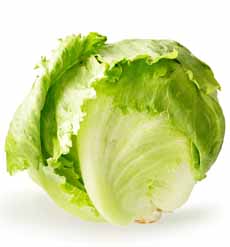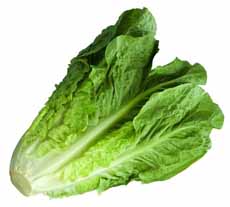DIY Wedge Salad Party Bar & The Different Types Of Lettuce
|
Back in the 1950s and 1960s, restaurant menus offered hearts of lettuce salad with creamy dressings. The head was cut into quarters and plated with a slice of tomato for color.
Homemakers were fans, too. Even James Beard was a fan, recommending the crisp texture mixed with other greens. Then came the California cuisine movement, introducing us to better varieties to eat. Iceberg was mocked for lacking flavor. Instead, foodies filled their shopping carts with romaine plus arugula and radicchio. Yet, hardy, crunchy iceberg still accounts for 70% of the lettuces raised in California (down from 80% in the mid-1970s, however). It’s still popular in food service (commercial, institutional), at salad bars, and at casual restaurants. And thanks to the retro food movement of the past decade, iceberg lettuce has returned to restaurant menus beyond the steakhouse, in the hearts of lettuce salad now known by a trendier name: wedge salad. Let the wedge salad add fun and crunch to your meals. If you have a daily dinner salad, feature the wedge once a week. Turn it into a DIY salad buffet for family and guests. An ingredients list is below. The crisphead (iceberg) lettuce variety is relatively new in the history of lettuce cultivation (see the different categories of lettuce, below). Crisphead lettuce was a mutation: A grower discovered a different-looking, sweeter-tasting head of lettuce in his field. Liking its flavor and superior crispness, he teamed with other growers to breed it to be even better. Thus was born what we today call iceberg lettuce. The new variety became a top seller and remains so. It was called crisphead, its given varietal name, until the 1920s. It subsequently acquired the name iceberg because of its ability to be transported for long distances when packed on ice. Before the iceberg named settled in, it was also called cabbage lettuce, for its resemblance to cabbage. In 1894, a Burpee seed catalog exclaimed, “There is no handsomer or more solid Cabbage Lettuce in cultivation.” Numerous varieties of crisphead were developed, including varieties with reddish leaves tinged with green and varieties with scalloped edges. While they did not enter the mass market, you can still buy the seeds from specialty sellers. Now about the wedge salad: Period cookbooks, newspapers, and culinary reference books date the popularity of iceberg lettuce salads to the 1920s. But the general consensus is that the wedge salad with creamy dressing became a ubiquitous menu entry in the 1950s. [source] Who served the first “hearts of lettuce salad,” as it was then called? Likely it was a steak house, given the popularity of that type of restaurant in the 1950s and the [still] ubiquitous presence on those menus. But as with so many things, we can only give credit to “an unknown cook.” |
 [1] California wedge salad with prosciutto crumbles. Here’s the recipe from Little Broken (photo © Little Broken).
|
|
 [4] The ubiquitous head of iceberg lettuce, also known as crisphead or head lettuce. Just quarter it for your wedge salad (photos #3 through #6 © Good Housekeeping).
|
DIY WEDGE SALAD BAR
At THE NIBBLE, we’ve added a lot to the simple wedge salad. Call it a DIY, customized, or signature wedge salad, it’s a fun munch. The Must Haves There are four basic types of lettuce: butterhead (photo #5), iceberg (photo #5), leaf (photo #6), and romaine (photo #7), along with hundreds of hybrids bred from them. Iceberg Lettuce: Also known as crisphead lettuce, iceberg is the most popular type of lettuce in the U.S. It’s the crispest and hardiest of lettuce varieties, lasting twice as long in the fridge as long as most other varieties. The downside: It’s not as flavorful or nutritious as other lettuces. Butterhead Lettuce: Comprising Boston and Bibb Lettuces, these are small, loosely formed heads of soft, supple leaves. Boston is a larger and fluffier head than Bibb; Bibb is the size of a fist, and sweeter than Boston. Both are excellent for lettuce cups. The leaves are sweet and tender. The downside: They’re highly perishable and bruise easily, and are pricier than iceberg and romaine. Leaf Lettuce: Also known as looseleaf, cutting or bunching lettuce, this category does not form a head. Instead, the leaves branch up from a single stalk. The leaves are very tender and are often seen in baby lettuce blends. The burgundy tint of red leaf lettuce and the spicier, nuttier oak leaf lettuce add charming color to a mixed green salad. The downside: Leaf lettuces are more perishable than head lettuces and wilt easily. They are used mainly for salads. Romaine Lettuce: Second in crunchiness to iceberg lettuce, romaine, also called cos, is a stalk lettuce that grows in upright stalks. The crunchy center ribs make the leaves sturdy, and they have a pleasant bitterness. Romaine is used mainly for salads and sandwiches, and is the lettuce used in Caesar Salad. When the outer leaves are trimmed, the smaller ones (sold as hearts of romaine) can be used as “boats” to hold protein salads (egg, chicken, tuna, etc.). Summercrisp Lettuce: Also called Batavian or French crisp lettuce, this variety falls midway between iceberg and leaf lettuces. They are very crisp like romaine, but sweet and juicy, without bitterness (photo #9, below). The shape of the summercrisp plant is initially open, much like a loose-leaf lettuce. It then matures into a heavy, compact bunch or head. Stem lettuce: Also called celtuce, celery lettuce, asparagus lettuce, or Chinese lettuce (among other names), stem lettuce is grown primarily for its thick stem rather than for its leaves (photo #8). The stalk is used in Asian cooking (primarily Chinese), as well as stewed and creamed dishes. It can also be shaved into ribbons for a salad. In a salad, the leaves are indistinguishable from other lettuce. The stems are traditionally stir-fried in Sichuan cooking. Prized for its woody stem, which looks like a thick asparagus stalk or wasabi root, celtuce has a nutty, cucumber-ish flavor. The stem can grow to 10-12 inches in length. |
|
 [9] Summercrisp lettuce varieties (photo © Johnny’s Selected Seeds). CHECK OUT WHAT’S HAPPENING ON OUR HOME PAGE, THENIBBLE.COM. |
||








